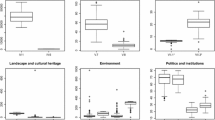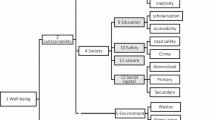Abstract
The official Italian well-being measuring system (“Equitable and Sustainable Well-being—BES”) is probably the worldwide most advanced attempt to pursue the beyond GDP perspective effectively. In it, well-being is described in terms of 12 domains and a complex multi-indicator system of around 130 indicators, drawn mainly from Istat (official Italian statistical bureau) surveys and administrative archives. In order to get a more synthetic view of well-being, in the last four BES reports Istat employed aggregative procedures providing composite indicators for each well-being domain. The aggregative road to synthesis is however problematic, when complex and non-highly correlated indicator systems are to be summarized, mainly due to its compensative nature and interpretational difficulties. As a valuable alternative, in this paper we adopt a non-aggregative approach to synthesis, based on Partially Ordered Set Theory (Poset Theory) and show how it can be used to provide more “complexity-preserving”insights into well-being. In particular, we describe each well-being domain as a partially ordered set and compute synthetic indicators for well-being rankings at regional level for year 2017, getting more robust and interpretable results than with mainstream aggregative procedures.









Similar content being viewed by others
Notes
According to Maggino (2017b), we can distinguish three different approaches: the fundamental process; the derived process and the defined process.
Linearity implies that to certain causes correspond certain effects, which vary following linear laws. This is a typical feature of simple systems. As shown by Érdi (2008), that type of systems is based on the principle of simple cause and a single effect and suggests that small changes in the cause imply small changes in the effect. It means that the system’s behavior is predictable. At the opposite, complex systems are based on circular causality and on the principle small change in the cause, dramatic effects.
The importance of inter-generational perspective in achieving human needs was stated for the first time by the so-called Brundtland Commission in 1987 (United Nations World Commission on Environment and Development 1987).
CNEL is a representative institution of trade associations, trade unions and the third sector sit.
The domains are: Health, Education and training, Work and life balance, Economic well-being, Social relationships, Politics and institutions, Safety, Subjective well-being, Landscape and cultural heritage, Environment, Innovation, research and creativity, Quality of services.
For the following domains, Istat produces two synthetic measures:
-
1.
Work and life balance: Employment and Quality of work;
-
2.
Economic well-being: Income and inequality and Minimum economic conditions;
-
3.
Safety: Homicides and Predatory Crime.
-
1.
As shown by Alaimo and Maggino (2019), each method has its strengths and weaknesses. The method used can have an impact on the results obtained; in particular, the weighting and the aggregation are critically important steps.
Note that, through the Min–Max standardization the problem of outliers appears. Another construction could be that of a purely distributional consideration, applying the theorem of Bienayme and Tschebyscheff (see Alaimo 2020), which is a robust statistical procedure.
For those indicators, Istat estimates data for the year 2017. Since the estimation is not available on the Istat website, we have decided to exclude those indicators rather than make our own estimation.
References
Alaimo, L. S., & Maggino, F. (2019). Sustainable development goals indicators at territorial level: Conceptual and methodological issues-the Italian perspective. Social Indicators Research. https://doi.org/10.1007/s11205-019-02162-4.
Alaimo, L. S. (2020). Complexity of social phenomena: Measurements, analysis, representations and synthesis. Unpublished doctoral dissertation. “La Sapienza”, Rome, Italy: University of Rome.
Atlan, H. (2015). Entre le cristal et la fumée. essai sur l’organisation du vivant. Paris: Edit. du Seuil.
Brulé, G., & Maggino, F. (2017). Towards more complexity in subjective well-being studies. In G. Brulé & F. Maggino (Eds.), Metrics of subjective well-being: Limits and improvements (pp. 1–17). Cham: Springer.
Capra, F. (1996). The web of life: A new scientific understanding of living things. New York: Anchor books.
Davey, B. A., & Priestley, H. A. (2002). Introduction to lattices and order. Cambridge: Cambridge University Press.
De Toni, A. F. & Comello, L. (2010). Journey into complexity. Venezia: Marsilio Editori.
Érdi, P. (2008). Complexity explained. Berlin: Springer.
Fattore, M. (2016). Partially ordered sets and the measurement of multidimensional ordinal deprivation. Social Indicators Research, 128(2), 835–858. https://doi.org/10.1007/s11205-015-1059-6.
Fattore, M. (2017). Synthesis of indicators: the non-aggregative approach. In F. Maggino (Ed.), Complexity in society: From indicators construction to their synthesis (pp. 193–212). Cham: Springer.
Fattore, M. (2018). Non-aggregated indicators of environmental sustainability. Silesian Statistical Review/Slaski Przeglad Statystyczny, 16(22), 7–22. https://doi.org/10.15611/sps.2018.16.01.
Giovannini, E., & Rondinella, T. (2012). Measuring equitable and sustainable wellbeing in Italy. In F. Maggino & G. Nuvolati (Eds.), Quality of life in Italy, research and reflections (pp. 9–25). Cham: Springer.
Italian National Institute of Statistics, Istat. (2015). Rapporto BES 2015: il benessere equo e sostenibile in Italia. Rome: Istat. https://www.istat.it/it/archivio/175169.
Kennedy, R. F. (1968). Speech at the University of Kansas. https://www.jfklibrary.org/learn/about-jfk/the-kennedy-family/robert-f-kennedy/robert-f-kennedy-speeches/remarks-at-the-university-of-kansas-march-18-1968.
Lima, M. (2013). Visual complexity: Mapping patterns of information. New York: Princeton Architectural Press.
Maggino, F. (2016). Challenges, needs and risks in defining wellbeing indicators. In F. Maggino (Ed.), A life devoted to quality of life (pp. 209–233). Cham: Springer.
Maggino, F. (2017a). Dealing with syntheses in a system of indicators. In F. Maggino (Ed.), Complexity in society: From indicators construction to their synthesis (pp. 115–137). Cham: Springer.
Maggino, F. (2017b). Developing indicators and managing the complexity. In F. Maggino (Ed.), Complexity in society: From indicators construction to their synthesis (pp. 87–114). Cham: Springer.
Maggino, F., & Alaimo, L. S. (forthcoming). Complexity and wellbeing: Measurement and analysis. In: Bruni, L., Smerilli, A., & De Rosa D. (eds). A modern guide to the economics of happiness, Edward Elgar Publishing, Cheltenham.
Mazziotta, M., & Pareto, A. (2013). Methods for constructing composite indices: One for all or all for one. Rivista Italiana di Economia Demografia e Statistica, 67(2), 67–80.
Mazziotta, M., & Pareto, A. (2016). On a generalized non-compensatory composite index for measuring socio-economic phenomena. Social Indicators Research, 127(3), 983–1003.
Meadows, D. H. (2009). Thinking in systems: A primer. London: Earthscan.
Meadows, D. H., Meadows, D. L., Randers, J., & Behrens, W. W, I. I. I. (1972). Limits to growth. New York: Universe Book.
Morin, E. (1977). La méthode. I. la nature de la nature. Paris: Le Seuil.
Neggers, J., & Kim, H. S. (1998). Basic posets. Singapore: World Scientific.
Prigogine, I. (1982). From being to becoming: Time and complexity in the physical sciences. San Francisco, CA: W.H. Freeman.
Schröder, B. (2002). Ordered set: An introduction. Boston: Birkäuser.
Stevens, S. S. (1946). On the theory of scales of measurement. Science, 103(2684), 677–680.
Tufte, E. R. (2001). The visual display of quantitative information (Vol. 2). Cheshire, CT: Graphics Press.
United Nations World Commission on Environment and Development, WCED. (1987). Our common future. The Brundtland report. Oxford: Oxford University Press.
Author information
Authors and Affiliations
Corresponding author
Additional information
Publisher's Note
Springer Nature remains neutral with regard to jurisdictional claims in published maps and institutional affiliations.
Rights and permissions
About this article
Cite this article
Alaimo, L.S., Arcagni, A., Fattore, M. et al. Measuring Equitable and Sustainable Well-Being in Italian Regions: The Non-aggregative Approach. Soc Indic Res 161, 711–733 (2022). https://doi.org/10.1007/s11205-020-02388-7
Accepted:
Published:
Issue Date:
DOI: https://doi.org/10.1007/s11205-020-02388-7




